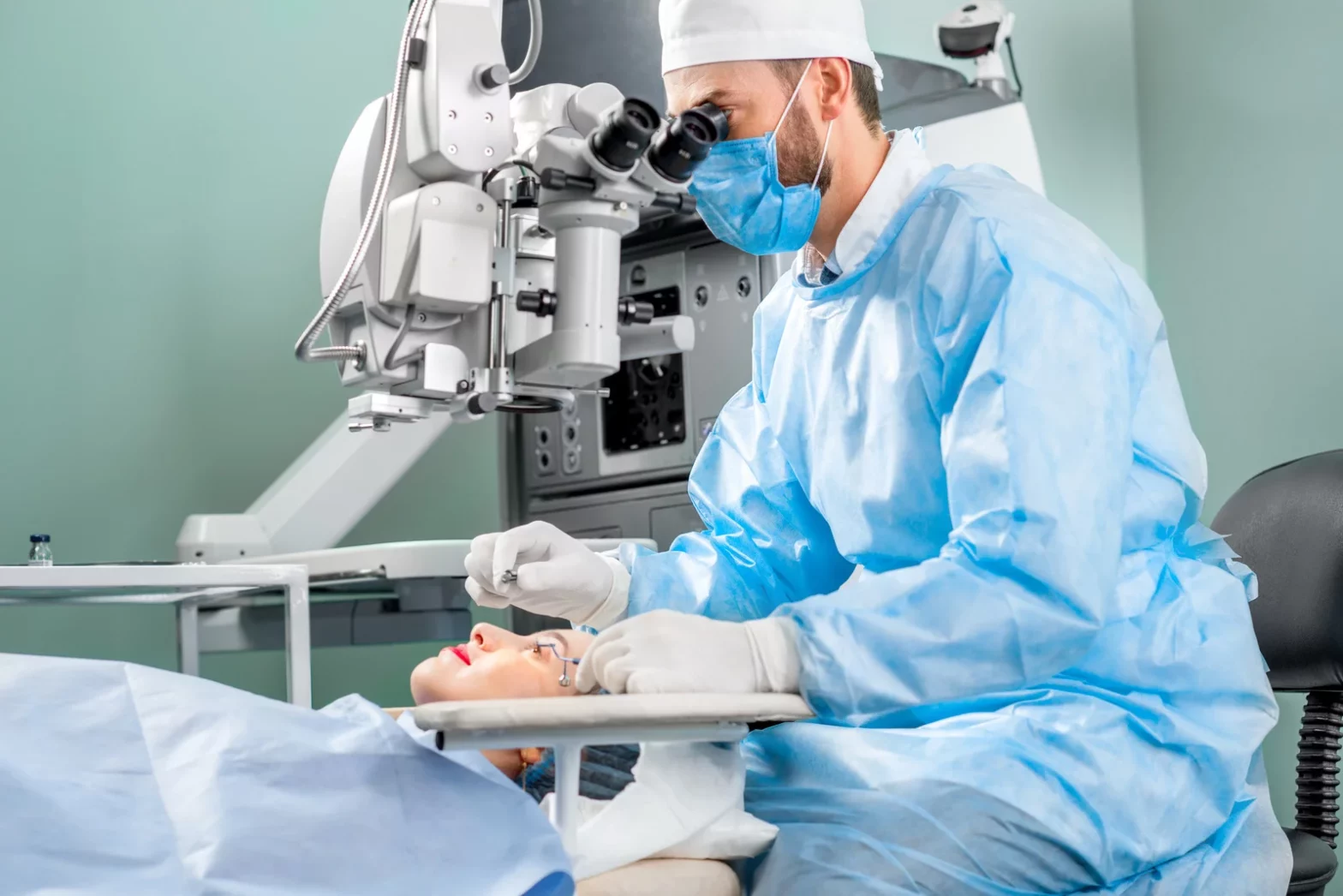In this comprehensive guide, we will walk you through all the important aspects of cataract eye surgery and the subsequent recovery process. Cataracts are a common eye condition that affects many individuals, particularly as they age. Understanding cataracts, preparing for surgery, knowing the procedure, managing post-surgery recovery, and being aware of potential complications are all essential for a successful treatment journey.
Understanding Cataracts
What are Cataracts?
Cataracts are clouding of the natural lens inside the eye. This cloudiness causes vision problems, such as blurry vision, difficulty seeing at night, and increased sensitivity to glare. Cataracts usually develop gradually over time and can occur in one or both eyes. They are primarily age-related but can also be caused by factors like diabetes, smoking, and prolonged sun exposure.
When light enters the eye, it passes through the clear lens to the retina, where images are processed and sent to the brain. A cataract eye surgery scatters and blocks the light as it passes through the lens, leading to blurred vision and other visual disturbances. Over time, the cataract may grow larger and denser, further impacting vision.
Causes and Risk Factors of Cataracts
The exact cause of cataracts is not fully understood, but various factors contribute to their development. Age is the most significant risk factor, as cataracts commonly affect individuals over the age of 60. Other risk factors include a family history of cataracts, certain medical conditions like diabetes or hypertension, previous eye injuries or surgeries, and prolonged use of certain medications like corticosteroids.
In addition to the mentioned risk factors, lifestyle choices can also play a role in the development of cataracts. Smoking, for instance, has been linked to an increased risk of cataract formation. The harmful chemicals in tobacco smoke can accelerate the clouding of the lens, leading to earlier onset and more severe cataracts. Furthermore, excessive alcohol consumption and poor nutrition lacking in essential vitamins and antioxidants may also contribute to the progression of cataracts. You can learn more about smoking at https://bss.sph.brown.edu/research/fields-research/smoking-and-tobacco-use

Preparing for Cataract Surgery
Initial Consultation and Eye Examination
The first step in preparing for cataract surgery is to schedule an initial consultation with an ophthalmologist or an eye surgeon. During this consultation, your eye will be thoroughly examined to determine the size, shape, and severity of the cataract. The ophthalmologist will use various tools and techniques such as a slit lamp examination and optical coherence tomography (OCT) to assess the condition of your eye in detail. Additionally, your overall health and medical history will be evaluated to ensure that you are a suitable candidate for surgery. The ophthalmologist will inquire about any existing medical conditions, allergies, and medications you are currently taking to tailor the surgical plan to your specific needs.
Choosing the Right Surgeon
Selecting the right surgeon is crucial to the success of your cataract surgery. Take the time to research and gather recommendations from trusted sources. Look for a surgeon who is experienced in performing cataract surgeries and has a good reputation. It’s essential to feel comfortable and confident in your surgeon’s expertise and communication skills. Consider asking the surgeon about their complication rates and success rates with similar cases to gain further insight into their proficiency. Additionally, you may want to inquire about the technology and techniques they use during cataract surgery, such as laser-assisted cataract surgery or premium intraocular lenses.
Pre-Surgery Instructions
Prior to your surgery date, your surgeon will provide you with specific pre-surgery instructions. These instructions may include refraining from eating or drinking for a certain period before the surgery, stopping certain medications that may interfere with the procedure, and arranging for transportation to and from the surgical facility. In some cases, you may be advised to use antibiotic eye drops to reduce the risk of infection after surgery. It is important to follow these instructions carefully to ensure a safe and successful procedure. If you have any questions or concerns about the pre-surgery instructions, do not hesitate to contact your surgeon for clarification.
The Cataract Surgery Procedure
Step-by-Step Process of Cataract Surgery
Cataract surgery is a common and highly successful outpatient procedure that aims to restore clear vision to individuals suffering from cataracts. The surgery involves the meticulous removal of the clouded natural lens from the eye, which is then replaced with a clear artificial intraocular lens (IOL). This replacement lens helps to improve vision and focus light properly onto the retina, allowing for clearer vision post-surgery.
Before the actual surgery begins, the patient is typically administered local anesthesia to numb the eye and ensure comfort throughout the procedure. This anesthesia helps to minimize any potential discomfort or pain during the surgery. Once the eye is numb, the surgeon proceeds with creating a small incision in the eye to access the clouded lens. Depending on the specific case, the surgeon may utilize advanced techniques such as ultrasound or laser to break up the cataract for easier removal.
Types of Cataract Surgery
There are various techniques available for cataract surgery, each with its own set of advantages and considerations. Two common methods include traditional phacoemulsification, where the cataract is broken up using ultrasound energy, and laser-assisted cataract surgery, which utilizes laser technology for greater precision. Your surgeon will carefully evaluate your eye health and individual needs to determine the most suitable approach for your cataract removal procedure.
Regardless of the technique used, the primary goal of cataract surgery remains consistent—to eliminate the cloudy lens and replace it with a clear artificial lens, ultimately enhancing visual acuity and quality of life for the patient.
Post-Surgery Care in the Hospital
Following the cataract surgery, patients are typically monitored in a recovery area to ensure a smooth transition from the procedure. It is common to experience some degree of discomfort, redness, and blurred vision immediately after surgery, which is a normal part of the healing process. To aid in recovery and prevent infection, patients are often prescribed a regimen of specialized eye drops to be used during the initial post-operative period.
Your surgeon will provide detailed instructions on how to care for your eye at home, including information on post-operative appointments, activities to avoid during recovery, and signs of potential complications to watch for. By following these guidelines and attending follow-up visits, patients can optimize their healing process and maximize the benefits of cataract surgery. To learn more about preventing infection click here.
Post-Surgery Recovery
What to Expect Immediately After Surgery
In the first few days following cataract surgery, it’s important to rest and give your eyes time to heal. You may experience fluctuations in vision, which is a normal part of the healing process. Your surgeon will schedule follow-up appointments to monitor your progress and address any concerns you may have. During this time, it is crucial to avoid strenuous activities and protect your eyes from dust, dirt, and excessive sunlight.
It is common to experience some discomfort, mild itching, or even a gritty sensation in your eyes after cataract surgery. This is normal and can be managed with the prescribed eye drops provided by your surgeon. Additionally, you may notice that colors appear more vibrant or that your vision is sharper as your eyes continue to heal.
Long-Term Recovery and Healing Process
While most individuals experience improved vision shortly after cataract surgery, it may take several weeks for your eyes to fully stabilize. Your surgeon will provide you with instructions on using prescribed eye drops and avoiding activities that could strain your eyes during the recovery period. It’s important to attend all scheduled follow-up appointments to ensure that your eyes are healing properly and that your visual acuity is improving as expected.
As your eyes continue to heal over the long term, you may notice a gradual improvement in your vision clarity and sharpness. Some patients report a significant reduction in glare sensitivity and an overall enhancement in their ability to see clearly in various lighting conditions. It’s essential to follow your surgeon’s recommendations regarding post-operative care to optimize your recovery and achieve the best possible visual outcomes.
Potential Complications and How to Handle Them

Common Post-Surgery Complications
Although cataract surgery is considered a safe and effective procedure, like any surgery, there can be potential complications. Some common complications include infection, inflammation, increased intraocular pressure, and posterior capsule opacification. Your surgeon will discuss these risks with you before the surgery and provide appropriate advice on preventing and managing complications.
It’s important to note that while these complications are possible, they occur infrequently and can often be effectively treated when addressed promptly. Infection, for example, can typically be managed with antibiotics, while inflammation may be controlled with anti-inflammatory medications. Increased intraocular pressure, if detected early, can be monitored and treated to prevent further complications.
When to Seek Medical Attention
If you experience severe pain, sudden or excessive vision changes, persistent redness, or increased eye discharge after cataract surgery, it is crucial to seek immediate medical attention. These could be signs of a complication or infection that require prompt treatment. Do not hesitate to contact your surgeon or the emergency department if you have any concerns during your recovery.
Additionally, it’s essential to follow the post-operative instructions provided by your healthcare team diligently. This includes using prescribed eye drops as directed, attending follow-up appointments, and avoiding activities that may put strain on the eyes. By adhering to these guidelines, you can help minimize the risk of complications and promote a smooth recovery process.
In conclusion, cataract eye surgery is an effective treatment for improving vision affected by cataracts. By understanding the condition, preparing for the surgery, and following the recovery process, you can achieve optimal outcomes and regain clear vision. Remember to consult with your healthcare team for personalized advice and support throughout your cataract treatment journey.
To learn more click here.
